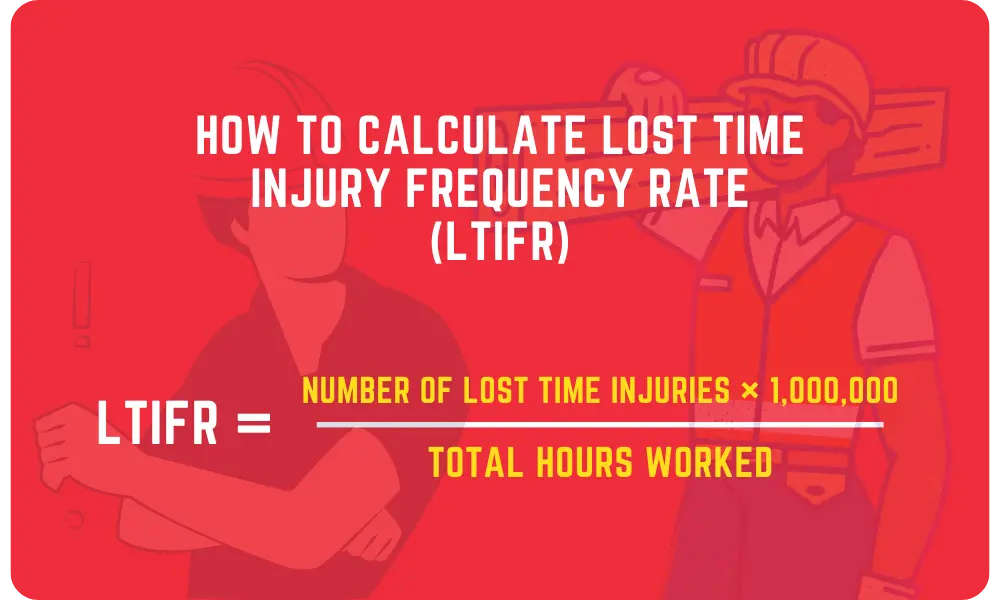Safety is paramount in every industry, and its measurement and improvement are critical to ensure a secure and productive work environment. One of the pivotal metrics guiding companies worldwide in this effort is the Lost Time Injury Frequency Rate (LTIFR). This metric provides insights into the effectiveness of safety measures and helps businesses benchmark their performance against industry standards.
This comprehensive guide delves deep into LTIFR—defining it, breaking down its calculation, and offering proven strategies to reduce it. Whether you’re a seasoned safety professional or just starting to familiarize yourself with industrial safety norms, this blog is a holistic resource on LTIFR. Join us as we navigate the intricacies of this crucial safety indicator and explore ways to enhance the well-being and safety of employees in the workplace.
What is the Lost Time Injury Frequency Rate (LTIFR)
The Lost Time Injury Frequency Rate (LTIFR) is a safety metric used to measure the frequency of lost time injuries in the workplace over a specific period relative to the total number of hours worked. It gauges how often serious injuries (resulting in time away from work) occur per a standardized number of work hours.
- Lost Time Injury (LTI): This is an injury sustained by an employee that results in them being unable to perform their regular duties, leading to them missing at least one full day (or shift) of work following the day of the injury.
- Frequency Rate (FR): By quantifying the occurrence rate of these LTIs against a set number of work hours, typically 1,000,000 hours, organizations can standardize and compare safety performance irrespective of the company size or total work hours.
LTIFR Formula
The standard formula for calculating LTIFR is:
LTIFR = Number of Lost Time Injuries × 1,000,000 / Total Hours Worked

How To Calculate Lost Time Injury Frequency Rate (LTIFR) With Example
The Lost Time Injury Frequency Rate (LTIFR) is a measure used to quantify the frequency of Lost Time Injuries against the total hours worked over a specific period. It allows organizations to gauge how often serious injuries, which lead to time off work, are occurring relative to the total working hours.
Here’s how you can calculate LTIFR:
Step 1: Identify the Number of Lost Time Injuries (LTI)
An LTI refers to any injury sustained by an employee that results in them missing at least one full day of work after the day the injury occurred.
Step 2: Determine the Total Hours Worked
This includes the cumulative hours worked by all employees during the specified period.
Step 3: Apply the LTIFR Formula
The standard formula for calculating LTIFR is:
LTIFR = Number of Lost Time Injuries × 1,000,000 / Total Hours Worked
To Elaborate With An Example
Let’s assume that during a year:
- Number of Lost Time Injuries = 5
- Total Hours Worked = 500,000 hours
Plugging these values into the formula:
LTIFR = 5×1,000,000/500,000
LTIFR = 5,000,000/500,000
LTIFR = 10

How To Reduce Your Lost Time Injury Frequency Rate (LTIFR)
Reducing the Lost Time Injury Frequency Rate (LTIFR) is crucial for creating a safer work environment, preserving the well-being of employees, and ensuring operational continuity. Here are several strategies organizations can implement to reduce their LTIFR:
1. Build a Strong Safety Culture
A strong safety culture begins at the top and permeates every level of an organization. By fostering a safety-first mindset, companies send a clear message that employee well-being is paramount. Leadership’s commitment to safety sets the tone for all employees. A crucial element in a safety culture is open communication.
Employees should feel confident and comfortable discussing safety concerns, knowing their input is valued and their concerns will be addressed promptly. They shouldn’t fear any negative consequences for raising safety issues, as retribution can hinder vital feedback necessary to prevent accidents.
2. Regular Training and Education
Continuous training ensures that every new or experienced employee understands the risks associated with their tasks and knows how to mitigate them. It’s not enough to simply inform employees about machinery operation and safety protocols once.
As technologies evolve and processes change, safety protocols may need updating. Offering refresher courses helps long-standing employees remain updated and reinforces the importance of safety.
3. Hazard Identification and Risk Assessment
A proactive approach to safety involves regularly identifying potential hazards before they cause harm. Regular safety audits and inspections are instrumental in pinpointing these risks. Once identified, it’s essential to assess these risks.
Not all hazards are of equal concern; some might pose a more significant threat due to the severity of the potential injury or the likelihood of occurrence. Prioritizing these risks allows companies to allocate resources more effectively.
4. Implement Safety Procedures and Protocols
A clear, well-documented set of procedures ensures that tasks, especially high-risk tasks, are carried out safely and consistently. These procedures act as a roadmap for employees, guiding them in the safest methods for task completion.
Standard operating procedures, or SOPs, are the backbone of operational safety. Their regular review and update ensure they remain relevant and effective in changing conditions or new information.

5. Invest in Personal Protective Equipment (PPE)
PPE acts as the last line of defense against hazards. It is essential to provide workers with the right equipment, whether safety goggles, hard hats, or gloves. But it’s not just about provision; ensuring that PPE is in good condition and fit for its purpose is equally important.
Furthermore, employees must know how to use PPE correctly. Training sessions can instill the importance of wearing PPE and educate on its proper usage.
6. Engage and Empower Employees
Safety isn’t the sole responsibility of a dedicated safety team; it’s a collective effort. Establishing safety committees with representatives across various organizational levels ensures diverse perspectives in addressing workplace safety challenges.
Such committees can also help in developing and refining safety strategies. Moreover, frontline workers often have firsthand insights into potential hazards, so encouraging them to report hazards and near-miss incidents can offer valuable information for preventive measures.
7. Incident Analysis
In the unfortunate event of an incident, it’s essential to understand its cause. Analyzing even minor incidents or near misses can offer insights into underlying issues that, if left unaddressed, could lead to more severe accidents in the future.
Root cause analysis helps determine the incident’s primary cause, beyond the apparent symptoms. Once identified, corrective actions can be taken to prevent recurrence. This approach ensures lessons are learned from every incident, driving continuous safety improvement.
8. Continuous Improvement
Just as industries evolve, so should safety measures. Regular reviews and analyses of safety performance data provide insights into areas needing more attention or different approaches. As new best practices emerge in the industry, they can be integrated into an organization’s safety strategies.
Being open to change and actively seeking ways to enhance safety protocols shows a proactive commitment to employee well-being and operational excellence.
9. Health and Well-being Programs
An effective safety program acknowledges the interconnectedness of physical and mental health. Employees in good physical and mental health are more alert, attentive, and less prone to accidents. Regular breaks can help prevent fatigue and burnout.
Ergonomic workstations reduce the risk of musculoskeletal injuries and improve overall comfort. Initiatives that help employees manage stress contribute to a more focused and attentive workforce, reducing the risk of lapses that could lead to accidents.
10. Use Technology
The digital age offers tools that can revolutionize workplace safety. Safety management systems, for instance, provide a centralized platform for reporting, tracking, and analyzing safety data. They offer insights that might not be readily apparent from isolated data points.
Wearables and Internet of Things (IoT) devices can provide real-time monitoring of environmental conditions or worker vitals, detecting potential hazards immediately and triggering alerts. Such instant feedback can be invaluable in preventing incidents.
11. Clear Communication
Communication acts as the bedrock of any effective safety program. Whenever protocols change or are updated, that information should be readily available and easily understood by all staff members. This ensures practice uniformity and reduces the risk of misunderstandings leading to accidents.
Visual reminders like posters, signs, and labels can serve as constant reminders, reinforcing the importance of safety in the workplace.
12. External Audits and Certifications
Sometimes, an outside perspective can identify gaps or areas for improvement that might be overlooked internally. Engaging third-party experts to conduct safety audits offers an unbiased assessment of the existing safety landscape.
Safety certifications validate an organization’s commitment to safety and provide a structured framework that guides continuous improvement efforts, ensuring alignment with globally recognized best practices.

13. Maintenance and Equipment Upgrades
Well-maintained machinery and equipment function as intended, reducing the risk of malfunctions that could lead to injuries. Regular inspections ensure that any wear and tear or potential issues are addressed promptly.
As technology advances, newer equipment models might incorporate safety features that were absent or rudimentary in older versions. Investing in such upgrades, when feasible, can lead to a safer operational environment.
14. Incentivize Safe Behavior
Human behavior is often influenced by incentives. Recognizing and rewarding employees for adhering to safety practices or for proactive measures that enhance safety can motivate others to follow suit. It creates a positive feedback loop where safe behavior becomes the norm, not the exception.
Programs that offer tangible rewards or bonuses for maintaining high safety standards further reinforce the idea that safety is not just a responsibility but is also valued and appreciated.
Conclusion
LTIFR stands as a vital beacon in workplace safety, guiding organizations toward a safer and more responsible operational environment. Understanding its definition and calculation is just the tip of the iceberg. The true essence lies in its application and the continuous endeavors to reduce it. By actively investing in safety measures, encouraging open communication, and integrating technology, businesses can move beyond just compliance to foster an environment where safety becomes a shared responsibility.
Remember, a lower LTIFR indicates a safer workspace and reflects a company’s dedication to the well-being of its most valuable asset—its employees. As we wrap up this comprehensive guide on LTIFR, let it serve as a reminder of the unwavering commitment we must all have toward creating productive and safe workplaces.

